Frangipani ( Plumeria rubra ) is one of the most popular tropical trees. It has thick fleshy branches, large deep green leaves and lovely fragrant flowers and is available in several colours. In temperate climates, , the plant drops it's leaves in winter. Larger plants are more hardy to very cold weather, but the trees will not appreciate frost. The Frangipani is a small tree growing to around 6 metres. It is easily propagated by cuttings in warmer months. Parts of the plant are toxic so handle carefully. These photos were taken on the Sydney harbourside, where they grow very well.
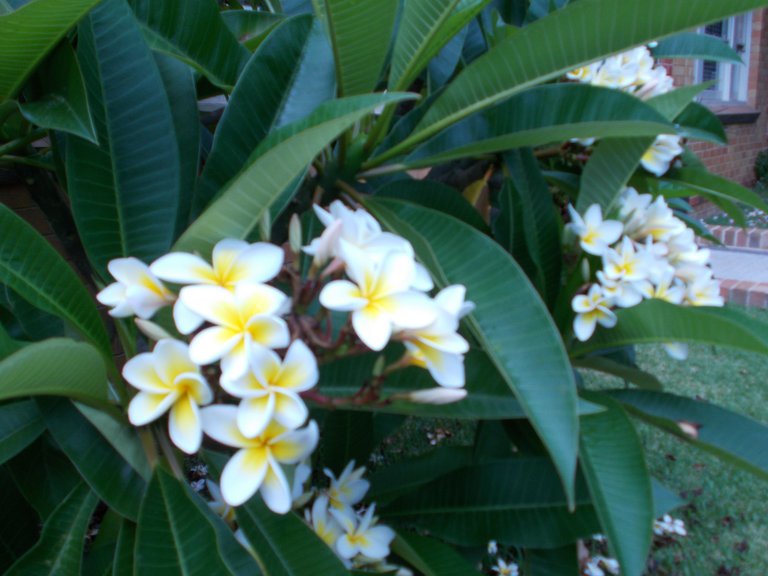

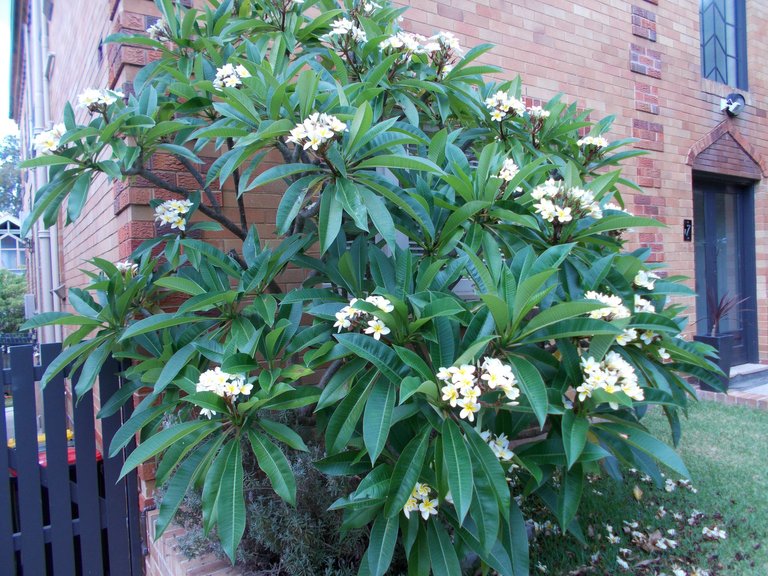
Plumeria rubra is a deciduous plant species belonging to the genus Plumeria. Originally native to Mexico, Central America, Colombia and Venezuela, it has been widely cultivated in subtropical and tropical climates worldwide and is a popular garden and park plant, as well as being used in temples and cemeteries. It grows as a spreading tree to 7–8 m (23–26 ft) high and wide, and is flushed with fragrant flowers of shades of pink, white and yellow over the summer and autumn. Its common names include frangipani,red paucipan, red-jasmine red frangipani, common frangipani, temple tree,or simply plumeria.
Plumeria rubra was one of the many species first described by the father of taxonomy Carl Linnaeus, and appeared in the 1753 edition of Species Plantarum. Its specific epithet is derived from the Latin ruber "red". The epithets acuminata, acutifolia, and lutea are seen, but these are invalid.
In Mexico the common name is Cacaloxochitl or Suchitl. The name comes from nahuatl and means Crow's flower.P. rubra was declared the national flower of Nicaragua in 1971, where it is known as sacuanjoche.[5] The common name in Australia is 'frangipani', although 'plumeria' is used in the United States. Other common names are 'red frangipani', 'common frangipani', 'temple tree', or simply 'plumeria'. The term melia is a Hawaiian one.The common name 'frangipani' comes from an Italian noblefamily, a sixteenth-century marquess of which invented a plumeria-scented perfume. In the Cook Islands, it is known as Tipani. It is grown extensively in southern and western parts of India, where it is named champa or a derivative thereof such as chaaphaa, champige etc. In Cambodia it is given the names châmpéi krahâ:m (also romanised as krahom, meaning 'red'), or châmpéi slük sruëch, while the French terms for the species is frangipanier à fleurs rouges.In Sri Lanka, it is known as 'Araliya', in sinhales
Source
This very beautiful garden and beautiful photography
thanks @ctrl-alt-nwo
Have a great day.
They have succulent bodies, thick and fleshy branches, and their homeland is tropical and subtropical America. In Asia, Buddhist Indians are referred to as the West Indian Bastard because it is the Indian Shrine Tree, Plumeria alba motherland Small Tortoises and Porta Rico, as they decorate their temples with the flamboyant and perfume-like flowers of this plant. In our country (Turkey), but needed to florists to have originated in America as the American coastline Fulda, homeland puppies are called Fitna by name in Cyprus. Apart from their homeland, they are used for landscaping and decoration in many tropical and subtropic countries.





Odor is not like any plant in the world, and every color has its own unique smell. Some are sweet, others have similar scents like jasmine, peach, citrus scent. As it can be grown all over the world, it can reach a tree length of 6 meters under suitable warm climatic conditions. You can also grow potted plants on your terrace, by the pool, or on your balcony. Plumeria is only as big as the pot that it is allowed to let. In the arising climates, you can let the plants continue to grow by ingesting the plants, or you can get them to sleep in a closed area or basement. With the spring, the plumerian will become larger than the previous year when the air is heated. It is one of the plants that requires the least maintenance of the world. It is resistant to drought and can be grown all or part in the sun.
Pic Source
Plumeria is the world's most perfect plant. Plumerias are tropics and subtropical Americas. In Asia, the Buddhist Indians adorned their temples with chic and fragrant flowers of this plant, the Indian Temple Tree, the Plumeria Alba country is called the western Indian Jasmine because it is a small Antilles and Porta Rico.Florists are known for their American origin in the Mediterranean coast, while florists are known for their American fauna in Cyprus.
1
Although flowers are not long-lasting, they remain flowering most of the year with new flowers. Its smell is unlike any other plant in the world, and every color has its own scent. Some are sweet, some have odors similar to Jasmine, peach and citrus. It can be grown all over the world, and it can reach a length of 6 meters in suitable warm climatic conditions. Besides, you can grow it on your terrace, on the pool side or on your balcony. Plumeria grows only as large as the pot it is in.In frost climates, you can allow the plant to continue to grow by letting in or by taking a closed area or basement to enter the sleep phase. When the weather warms up with the spring, your plumeria will open bigger than the previous year.
2
The Plumeria plant is very easy to grow from its seed.ohms have tiny comets that you can plant them into the soil. Be sure to use good drainage, good quality planting soil containing some perlite. You can use cactus mixtures for this job.Don't forget to spray the soil frequently during this time. The spray also softens the seed walls and makes it easier to split.Seeds can also be germinated in damp paper towels. Moisten the paper towel and lightly squeeze it to avoid too wet. Fold in four and place the seed between the layers. At this point, make sure the towel is completely in contact with the seed. A plumeria requires four years of labor from seed to flower.
3
There is a lore which says that the name Frangipani derives from a perfume created by an Italian family of the same name. Frangipani, also known as the Plumeria, is native to warm tropical areas of the Pacific Islands, Caribbean, South America and Mexico. They can grow to be large shrubs or even small trees in mild areas of the U.S. In tropical regions, Plumeria may reach a height of 30' to 40' and half as wide. Their widely spaced thick succulent branches are round or pointed, and have long leather, fleshy leaves in clusters near the branch tips. Leaves tend to fall in early winter since they are deciduous and sensitive to cold. Common White Frangipani has very fragrant white flowers with yellow centers. The petals are small and strongly overlapping, giving the impression of a flower in the process of unfolding.
4
@ctrl-alt-nwo, Flamboyant Frangipani flowers is very beautiful, colorful and better smell indeed. Leaves also attractive. My country has lot of trees and grow faster. I add more information via web. Frangipani flowers evoke different emotions, depending on culture. In down-to-earth Australia they’re backyard survivors, beating near-death experiences from some of the most brutal pruning I’ve ever seen. Everywhere they’re grown, their fresh flowers are scattered in pools and bowls as a finishing touch before special events. You can even order fresh frangipani flowers by mail. They’re a favourite in Buddhist temples too, while in some parts of South-East Asia they’re associated with demons and vampires.
To grow frangipanis in containers, particularly plastic pots, use a premium-grade potting mix without added wetting agents or water crystals. Terracotta pots benefit growth. They are porous, which helps drainage while discouraging root-rot. In addition to this, container-grown frangipanis can become top-heavy and the weight of the terracotta pot balances this. Terracotta also warms in sunshine, helping frangipanis succeed in temperate climates.
Before planting loosen the soil and add compost. For clay soils, work in gypsum at the recommended rate to improve air and water movement. Planting in a mound, about 15cm above the surface, improves drainage in clay.
Transplant during the warm seasons when recovery is fastest. Retain as many roots as possible and firmly stake until strong anchoring roots develop, this usually takes about 12 months.
Planting near masonry walls, buildings or in paved areas provides shelter from wintry winds and reflects warmth. Frangipanis grow about 30–60cm a year, depending on climate and care. They need full sunshine and a fertile, free-draining soil. Sandy or sandy-loam soils are ideal. Frangipani trees have compact, non-invasive root systems, so they can be grown safely near pipes and cables or in narrow beds. They respond well to pruning too. To keep trees compact and bushy, prune branches back by one-third in late summer.
Image source:google
contents source: http://www.homelife.com.au/gardening/plant-guides/plant-guide-frangipanis
The moment someone mentions the word frangipani my nostrils begin to seek that aroma as if it were a natural physical attraction. For once you’ve breathed in the fragrance of these flowers there’s no going back it will become indelibly stamped upon your senses.But then for the remainder of the year the plant looks like a naked twig taking up space that could be occupied by something far more productive.
It’s this love/hate relationship I have frangipani’s. When it’s flowering there is no competitor. When it’s not you could try to hide the stems with aluminum foil and it would still gain more respect. No folks, the frangipani needs to be grown as an architectural plant. Or, at the very last within a tropical grouping surrounded by flowering canna lillies, bromeliads or tillandsias.
In it’s natural environment the frangipani grows wild in Central and South America – picture the climate! Warm tropical days where frost is never present. Frangipani would grow well in most coastal areas around Australia and the lower third of the US. If kept indoors it may even be grown quite successfully in most other parts as well.
Plumeria rubra, it’s scientific name, are available as evergreens although you rarely see them growing – as most specimens are deciduous. They can grow to nearly 8m (26ft) or more and span 3-4m(13ft), resembling a phallic sculpture during their dormant season.
Their gorgeously fragranted flowers aren’t just limited to the common white with yellow centres either. They range from dusted apricots through coral pinks and even extend the palette through to dark reds which makes their desirability even greater.
Plumeria, which are from the most beautiful plants in the world, are apocynaceae class, shrubs or small trees, which are leafy or semi-green, 8 kinds.
Source:
They have succulent bodies, thick and fleshy branches, and their homeland is tropical and subtropical America. On the Asian side, Buddhist Indians are also called the Indian Shrine Tree (plant) because their temples decorate this plant with the stunning, perfume-like flowers. Apart from their homeland, they are used for landscaping and decoration in many tropical and subtropic countries. Plumeria are freeze-resistant, produced from seed or steel.
Source:
Plumeria is named for the West Indian Cistern for the alba motherland of the Small Antilles and Porta Rico. It can be described as a broad bush or a short broad tree. The dark green leaves on the plump branches reach 25-30 cm in length, with the bottoms lightly tufted. It is a tree that can reach 6 meters high and 4 meters wide. White, colorful, fragrant, perfume-scented flowers with yellow eyes in the middle open all summer and autumn.
It is possible to produce this plant, which is a tree in Rhodes, Cyprus, Alanya, on the Mediterranean coastline, sheltered places or greenhouse conditions. These wonderful plants with up to 300cm paint samples are being sold in the palm center gardens.
Plumeria rubra is of Mexican origin, Panama. It is very similar to the above. Trees can reach slightly larger paint than Plumeria albino. The flowers with yellow eyes around them are usually rose pink, sometimes yellow, red or bronze. There are samples reaching to 150-200cm paint in palm center gardens and sold.
Source:
[Source:](
Source:
Plumeria rubra is a deciduous plant species belonging to the genus Plumeria.Originally native to Mexico, Central America, Colombia and Venezuela, it has been widely cultivated in subtropical and tropical climates worldwide and is a popular garden and park plant, as well as being used in temples and cemeteries. It grows as a spreading tree to 7–8 m (23–26 ft) high and wide, and is flushed with fragrant flowers of shades of pink, white and yellow over the summer and autumn. Its common names include frangipani, red paucipan, red-jasmine, red frangipani, common frangipani, temple tree, or simply plumeria.
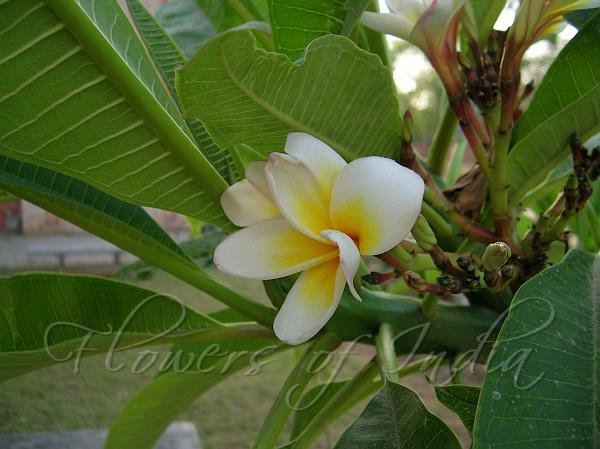
_(4125134278).jpg)
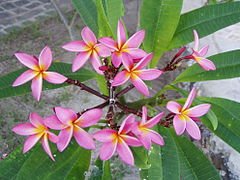
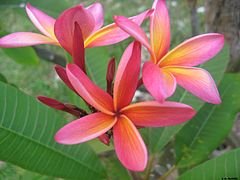

.jpg)
Plumeria rubra was one of the many species first described by the father of taxonomy Carl Linnaeus, and appeared in the 1753 edition of Species Plantarum. Its specific epithet is derived from the Latin ruber "red". The epithets acuminata, acutifolia, and lutea are seen, but these are invalid.
Common Names:
In Mexico the common name is Cacaloxochitl or Suchitl. The name comes from nahuatl and means Crow's flower. P. rubra was declared the national flower of Nicaragua in 1971, where it is known as sacuanjoche. The common name in Australia is 'frangipani', although 'plumeria' is used in the United States. Other common names are 'red frangipani', 'common frangipani', 'temple tree', or simply 'plumeria'. The term melia is a Hawaiian one. The common name 'frangipani' comes from an Italian noblefamily, a sixteenth-century marquess of which invented a plumeria-scented perfume. In the Cook Islands, it is known as Tipani. It is grown extensively in southern and western parts of India, where it is named champa or a derivative thereof such as chaaphaa, champige etc. In Cambodia it is given the names châmpéi krahâ:m (also romanised as krahom, meaning 'red'), or châmpéi slük sruëch, while the French terms for the species is frangipanier à fleurs rouges In Sri Lanka, it is known as 'Araliya', in sinhalese.
Close-up on flowers of a white variant
Close-up on flowers of a pink variant
Plumeria rubra in Tahiti
Red frangipani in Warje, India.
Plumeria rubra in China
Source
Thanks for reading @ctrl-alt-nwo
Frangipani prefers dry, warm and frost-free climates. It is hardy grown outdoors in Sunset’s Climate Zones 12, 13, 19, 21 through 24, H1 and H2. Gardeners residing in cooler locations should grow it in containers. Bring potted plants indoors when temperatures drop to 32 degrees F. For the best performance and blooms, grow in full to partial sun. Trees receiving six to eight hours of sunlight produce the most abundant blooms, according to the South California Plumeria Society. Frangipani benefits from afternoon shade when summer conditions are dry, sunny and hot. The tree is moderately salt-tolerant.
Prune frangipani only to control its size or shape or to remove broken and diseased branches. Use loppers or bypass pruners. Trim the branch flush to its joining point on a main branch or trunk. Avoid ripping and damaging the tree's bark by removing long and heavy branches by starting the first cut approximately 12 inches from the main branch. Prune through a third of the branch, cutting from bottom to top. Make the second cut approximately 1 inch from the first cut. Prune through a third of the branch, cutting from top to bottom. Lastly, cut the branch off flush to the trunk and it should fall without trunk damage. Frangipani tolerates pruning year-round, though winter pruning reduces springtime flowers.
@ctrl-alt-nwo,
Flamboyant Frangipani = Araliya (Local name) of my country! Beautiful photography of it!
Cheers~
Nothing evokes that tropical feeling quite like the frangipani. Their sweet scent and sheer beauty make them universally loved and the blooms look sensational on the tree and as a cut flower. Pick up some freshly fallen blooms and float them in a bath or bowl of water and it's easy to feel you're relaxing in a fabulous tropical day spa!
Picture Source
Most familiar in their white and yellow form, they also come in loads of tropical and sunset colours, becoming more colourful the closer to the equator you go. Frangipanis are also tough plants that can survive neglect, heat and drought and still fill the garden with a wonderful perfume. What more could you ask for in a tree?
Picture Source
Frangipanis are relatively small trees growing only to about 6m in height (about 20 feet), but what they lack in height they make up in width often becoming as wide as they are tall. Frangipanis are also great survivors coping with insect and pest attack. A cut made on any part of the tree will exude a milky, sticky sap that is poisonous to both humans and animals.
Picture Source
Frangipani Myths and Legends
Picture Source
If you know someone who is keen on bonsai, and would like to give them a bonsai related present, Frangipani bonsai tree would be a perfect gift.
Picture Source
Plumeria ‘Peace’ (Plumeria rubra hybrid)
Sweetly fragrant flowers are brilliant pink with large, orange centers. The 3” flowers appear in clusters of 10-12 blossoms, and it blooms heavily from summer through fall. This Thai variety is a deciduous plumeria that goes dormant every winter and re-sprouts new leaves in the spring. Grow in full sun to maintain steady blooming throughout the summer and early fall. This is a grafted plant that blooms sooner. Our supply is limited. Please order early.
In Indonesia, where the flower has been commonly associated with Balinese culture, it is known as kamboja, in Bali especially it is known as jepun. In French Polynesia it is called tipanie or tipanier and tīpani in the Cook Islands. In the Philippines it is called kalachuchi.”
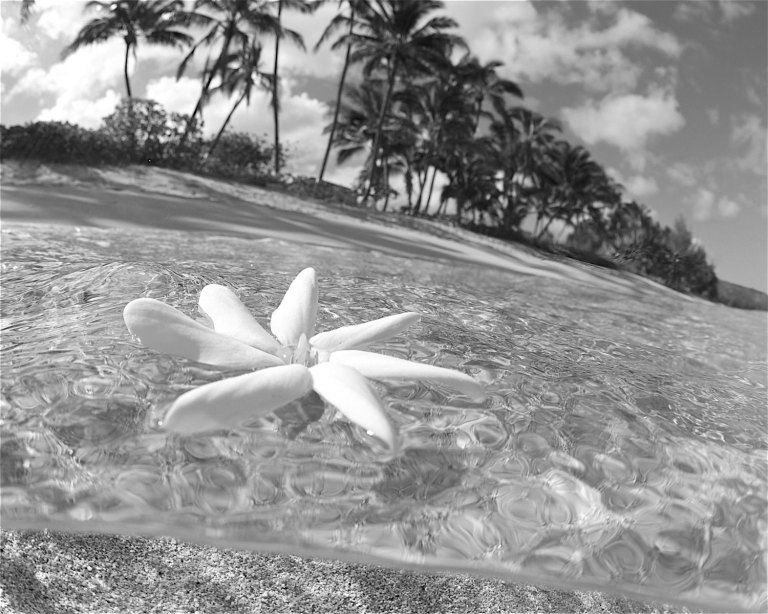
Plumeria (a group called Plumeria Growers) is the world's finest plant. The plumeria are the tropical and subtropical America. On the Asian side, Buddhist Indians are called the West Indies, because the Indian Shrine Tree, Plumeria alba homeland, Small Antilles and Porta Rico, are embroidered with the flamboyant and perfume-like flowers of this plant. Because of the American origin of the mediterranean coastline The flower shop is known as Fitne flower in American Fulu Cyprus. The sight is wonderful and Nisandan Kasyama is flowering between spring and autumn. Although flowers are not long-lived, new blooms remain flowered most of the year. Odor is not like any plant in the world, and every color has its own unique smell. Some are sweet, others have similar scents like jasmine, peach, citrus scent. As it can be grown all over the world, it can reach a tree length of 6 meters under suitable warm climatic conditions. You can also grow potted plants on your terrace, by the pool, or on your balcony. Plumeria is only as big as the pot that it is allowed to let. In the arid climates, you can let the plants continue growing by ingesting the plants, or you can get them to sleep in a closed area or basement. With the spring, the plumerian will become larger than the previous year when the air is heated. It is one of the plants that requires the least maintenance of the world. It is resistant to drought and can be grown all or part in the sun.
Source
Source
Source
Source
The plumeria flower has spread throughout the world after the discovery of the American continent. It is used as an ornamental plant in Buddhist and Hindu temples in some Asian countries. In these temples the name is 'Indian shrine flower'. In some places it is referred to as blessed oleander.
This plant, commonly known as Hawaii flower, has a lot of use in Hawaii. If you are thinking of a flower tattoo, you should certainly consider it in this flower. You can use any color you want in this type of flower beating, or you can carry this tattoo in your vogue with only shading style.
It will be a striking tattoo with its colors, giving it a very nice look when it is made to the shoulder or waist region according to the desired size.
Source
Source
A plumeria requires 4 years of labor from seed.
Plumeria are very special flowers. DEFINITELY VALUE TO WAIT.
Source1
Source2
Source3
Source4
Source5
this is a really very good flower of plumeria frangipani.... i love flower...i have a garden my house.. Description
5 Seeds of Plumeria Frangipani (Indian Yasmine)
Flower Color: unknown.
You get 5 seeds of unknown color. The mother plant is rose-yellow, father plant is white-yellow. You will probably get a plant with mixed color or something totally new.
The Plumeria or Frangipani or Indian Yasmine is a genus of flowering plants in the dogbane family, Apocynaceae. Most species are deciduous shrubs or small trees. Plumeria flowers are most fragrant at night in order to lure moths to pollinate them. Plumeria are cultivated due to their color and fragrance in the tropical belt. The branches have a diameter of 2-3 cm and the leaves can grow over 30 cm in length. In their natural habitat they can grow up to 5-8 m, in our regions i a pot only up to 2,5 - 3 m. You can cut the flower very easily and she will branch up to 5 and more new branches at the cutting spot. Naturally it will only branch after Blooming and will looks a lot nicer than after cutting. When cutting the new branches will grow on the cutting side and look a bit like glued on.
Natural habitat: Mexico, Hawaii, Thailand Flower:
Large big flower pots with lots of 5-leaf- Blossoms with colors from snow white, yello to dark pink and with mixed colors like pink-orange-yellow, or pink yellow white and many shades inbetween.
Propagation:
Plumeria seeds need high temperature and high humidity to grow. Place your seeds perpendicular in potting soil (small side up). Best soil is a mix of normal potting soil mixed with cactus soil or use special Plumeria soil. Keep humidity up, dont water to often, keep more dry than wet.
Place/Light:
In our temperatures she only grows in a pot. She loves high humidity and full sun. You can keep humidity up by spraying the plant with water once in a while. In Summer she loves a place outside in the sun. On cooler days a place inside is best (south window).
Care:
She loves sun and high humidity which will give yxou larger leaves and flowers. The Plumeria will also tolerate dry air but leaf and flower will grow smaller. You can even find plumeria in Egypt as garden plant in parks.
Keep soil moist but not wet, extra water in the plant pot should be removed. If you keep the plant to wet it will get mushy. So a bit dryer is better.
Do not keep her at temperatures lower than 10° Celsius for a long time. The the cooler the air the dryer the soil, the warmer the air the moister the soil.
To encourage flower growth keep the plumeria at a steady temperature around 20° celsius as long as you can. The best is when you keep her al year around warm at a very well lightes spot, she will bloom early and blooming period will be longer than normal. If you keep the seed at the same temperature all the time, your Plumeria will get Flowers fast than at a cooler darker spot.
Fertilize at least 1-2x /month, spring till fall.
Winter:
Plumeria does not tolerate temperatures below 10°, optimal temperature is 12° Celsius and higher, but if you can manage a best would be 20°. She will loose all her leaves in Winter. In Warmer temperatures she may keep some or if she lost all leaves will begin earlier with new ones around january. In our temperatures she will start at march/april. The faster you get her a warm place and as much light as possible the faster and longer she will bloom. When she has "refueled" with sunlight she will grow faster and better.Rest period is about october/november. In this time do not water or fertilize the plant.thanks to sharing good post
Most recognizable in their white and yellow frame, they likewise come in heaps of tropical and dusk hues, winding up more brilliant the nearer to the equator you go. Frangipanis are likewise intense plants that can survive disregard, warmth and dry season and still fill the garden with a superb scent. What more would you be able to request in a tree?
Description:Frangipanis are moderately little trees becoming just to around 5-6m in stature, yet what they need in tallness they make up in width frequently getting to be as wide as they are tall. They have a very much carried on root framework which makes them incredible for the home garden and for developing in pots. Frangipanis are likewise extraordinary survivors adapting to dry season, warmth, disregard and bug and vermin assault. They are likewise deciduous permitting most extreme winter sun while giving shade in summer.
With its contorted branches, long leaves and unmistakable blossoms, the frangipani is effortlessly a standout amongst the most well-known and identifiable trees. The bark is dark/green and textured in appearance. The scaling is framed when leaves drop in winter leaving little semi-round blemishes on the bark. The branches have a swollen appearance and the leaves, dim green on the best and a lighter shade of green underneath, group at the tips of branches. A cut made on any piece of the tree will ooze a smooth, sticky sap that is noxious to the two people and creatures.
Frangipani blossoms show up in groups, additionally toward the finish of the branches, and are particularly scented. The petals are waxy with the focal point of the bloom an alternate shading to the rest. For instance the most well-known frangipani has white blossoms with a yellow focus. There are numerous assortments running from profound dark red to orange , yellow and white (and each shade in the middle). Not at all like some blossoming trees which sprout for a couple of days or weeks, frangipanis continue blooming. Blossoms show up from December to April in Australia, and significantly longer in hotter atmospheres.
Varieties:Plumeria (basic name Frangipani) is a little class of 7-8 species local to tropical and subtropical Americas. The family comprises of predominantly deciduous bushes and trees. From Mexico and Central America, Plumeria has spread to every single tropical region of the world, particularly Hawaii, where it develops so plentifully that numerous individuals surmise that it is indigenous there.
Plumeria is identified with the Oleander (Nerium oleander) and both have toxic, smooth sap, somewhat like that of Euphorbia. Every one of the different types of Plumeria bears contrastingly molded leaves and their frame and development propensities are additionally unmistakable.
Plumeria Obtusa is a for the most part evergreen tree (decidous in dry seasons) with spreading branches and an adjusted arch. In spite of the fact that its basic name is "Singapore", it is initially from Colombia. Stature to 8m and spread to 4m. Leaves are indicated and oval up 18cm long. Tubular fragrant blooms happen in summer - pre-winter.
Plumeria Rubra (and variety Plumeria Acutifolia) otherwise called the Common Frangipani or Red Frangipani, is local to Mexico, Central America, and Venezuela. It is a decidous, spreading, scantily expanded tree or bush with a stature to 4m and spread to 4m and then some. Produces fragrant blooms with 5 spreading petals, extending from yellow to pink contingent upon shape or cultivar, in summer to fall. Leaves are spear molded to oval, and 20cm to 30cm long.
Another nice flower post you made.This is very popular in some part of the world.
Plumeria (/pluːˈmɛriə/) is a genus of flowering plants in the dogbane family, Apocynaceae.[1] Most species are deciduous shrubs or small trees. The species variously are indigenous to Mexico, Central America, and the Caribbean, and as far south as Brazil, but are grown as cosmopolitan ornamentals in warm regions.[2][3] Common names for plants in the genus vary widely according to region, variety, and whim, but frangipani or variations on that theme are the most common. Plumeria also is used directly as a common name, especially in horticultural circles.
Description-Plumeria flowers are most fragrant at night in order to lure sphinx moths to pollinate them. The flowers yield no nectar, however, and simply trick their pollinators. The moths inadvertently pollinate them by transferring pollen from flower to flower in their fruitless search for nectar.
Plumeria species may be propagated easily by cutting leafless stem tips in spring. Cuttings are allowed to dry at the base before planting in well-drained soil. Cuttings are particularly susceptible to rot in moist soil.
There are more than 300 named varieties of Plumeria.
Etymology and common names-The genus is named in honor of the seventeenth-century French botanist Charles Plumier, who traveled to the New World documenting many plant and animal species.[5] The common name "frangipani" comes from a sixteenth-century marquis of the noble family in Italy who claimed to invent a plumeria-scented perfume,[6] but in reality made a synthetic perfume that was said at the time to resemble the odor of the recently discovered flowers.[7] Many English speakers also simply use the generic name "plumeria".
In Persian, the name is yas or yasmin.In Bengali the name is "Kath Golap", in Hindi, champa, in Gujarati language, "Champo", in Marathi chafa, in Telugu deva ganneru (divine nerium), in Meitei khagi leihao. In Hawaii, the name is melia, although common usage is still 'plumeria'. In Malayalam it is called pāla and chempakam. In Sri Lanka, it is referred to as araliya and (in English) as the 'Temple Tree'. In Cantonese, it is known as gaai daan fa or the 'egg yolk flower' tree. The name lilawadi (originating from Thai) is found occasionally. In Indonesia, where the flower has been commonly associated with Balinese culture, it is known as kamboja, in Bali especially it is known as jepun. In French Polynesia it is called tipanie or tipanier and tīpani in the Cook Islands. In the Philippines it is called kalachuchi.



In culture-In Mesoamerica plumerias have carried complex symbolic significance for over 2000 years, with striking examples from the Maya and Aztec periods into the present. Among the Maya, plumerias have been associated with deities representing life and fertility, and the flowers also became strongly connected with female sexuality. Nahuatl speaking people during the height of the Aztec Empire used plumerias to signify elite status, and planted plumeria trees in the gardens of nobles.
These are now common naturalised plants in southern and southeastern Asia. In local folk beliefs they provide shelter to ghosts and demons. The scent of the plumeria has been associated with a vampire in Malay folklore, the pontianak; frangipani trees are often planted in cemeteries. They are associated with temples in both Hindu, Jain, and Buddhist cultures.
In several Pacific islands, such as Tahiti, Fiji, Samoa, Hawaii, New Zealand, Tonga, and the Cook Islands plumeria species are used for making leis. In modern Polynesian culture, the flower can be worn by women to indicate their relationship status—over the right ear if seeking a relationship, and over the left if taken.
This flower has a great value to some religion like hindu,buddhist.They think this flower as sacred.This is i have got for you.Article source internet.
Another interesting post by @ctrl-alt-nwo sir.I am sure a lots of information will come out by different kinds of comment.Here i am presenting some interesting information about Frangipani tree.


1-According to Mexican myth the gods were born from Frangipani flowers.
2-Frangipani (Plumeria) is very rare in China, and even more precious than orchids. So, when a person gives frangipani flowers to a sweetheart, it is the closest thing to saying you're special, I love you in a culture where expression of personal feelings is frowned upon.
3-The colorful caterpillar of Pseudosphinx tetrio feeds predominantly on the leaves of Plumeria rubra (frangipani).
4-"Warming" oils -- such as those from frangipani are said to have a calming influence on those suffering from fear, anxiety, insomnia or tremors, according to the principles of Ayurveda, a 5,000-year-old Indian holistic science that seeks to balance mind, body and spirit.
5-Frangipanis are good hosts for dendrobium orchids.
6-According to Vietnamese myth, ghosts live in trees with white and fragrant flowers including the frangipani. In Vietnam and China the colour white is associated with death and funerals.
7-In Hindu culture, the flower means loyalty. Hindu women put a flower in their hair on their wedding days to show their loyalty to their husbands.
8-There is a theory that Catholic missionary priests spread frangipanis around the world as they travelled. This may explain why the frangipani is so popular and common in the Philippines and Thailand but very rare in China and Vietnam. Thailand and the Philippines welcomed the Christian missionaries while, in China and Vietnam, they were persecuted until around the 1850s.
9-The frangipani is regarded as a sacred tree in Laos and every Buddhist temple in that country has them planted in their courtyards.
10-Frangipanis won't burn except in extreme temperatures (over 500 degrees).
11-In Caribbean cultures the leaves are used as poultices (a healing wrap) for bruises and ulcers and the latex (sap) is used as a liniment for rheumatism.
12-The frangipani is also associated with love in feng shui.
13-In India the frangipani is a symbol of immortality because of its ability to produce leaves and flowers even after it has been lifted out of the soil. It is often planted near temples and graveyards, where the fresh flowers fall daily upon the tombs.
14-In Vietnam the frangipani is used for its healing qualities: the bark, mashed in alcohol, prevents skin inflammation. It is also used to treat indigestion and high blood pressure, while the roots have purgative effects on animals and the milk-like sap serves as a balm for skin diseases. The white flowers are used in traditional medicine to cure high blood pressure, haemophilia, cough, dysentery and fever.
15-In Malay folklore the scent of the frangipani is associated with a vampire, the pontianak.
16-In modern Polynesian culture, the frangipani can be worn by women to indicate their relationship status - over the right ear if seeking a relationship, and over the left if taken.
17-Frangipani trees were once considered taboo in Thai homes because of superstitious associations with the plant's Thai name, lantom, which is similar to ratom, the Thai word for sorrow. As a result, frangipanis were thought to bring unhappiness. Today, however, the blossoms are presented as fragrant offerings to Buddha and Thai people wear them on special festival days like Songkran (Thai New Year).
18-The frangipani is the national flower of Nicaragua and it features on some of their bank notes.
19-The name, frangipani, comes from the Italian nobleman, Marquis Frangipani, who created a perfume used to scent gloves in the 16th century. When the frangipani flower was discovered its natural perfume reminded people of the scented gloves, and so the flower was called frangipani. Another version has it that the name, frangipani, is from the French frangipanier which is a type of coagulated milk that the Plumeria milk resembles.
20-The name, Plumeria, is attributed to Charles Plumier, a 17th Century French botanist who travelled to the New World documenting many plant and animal species, although according to author Peter Loewer (The Evening Garden: Flowers and Fragrance from Dusk Till Dawn; Timber Press, 2002) Plumier was not the first to describe Plumeria. That honour goes to Francisco de Mendoza, a Spanish priest who did so in 1522.
I think you will like this information about frangipani.
Article Source:Google.
With our gorgeous blossoms and unmistakable fragrance, a frangipani is an ideal tree for the garden, whether you entertain in its shade or simply sit, admire its blooms and take in its irresistible scent.
Frangipani blooms appear in summer and continue flowering well into autumn. They are available in countless single and bi-colour combinations, from the classic yellow and white to pastel pinks and oranges, and even striking reds and lilacs. Although the blooms look delicate, the trees are robust, with long lives, and can grow up to 8m tall. And if you’re short on space there are also compact choices.
Frangipanis are quite easily propagated from cuttings the trick is to allow the cutting base to dry out and callous over before planting. Late spring to early summer is a good time to take cuttings, but almost any time will do. Simply cut lengths of stems or lop off a branch, then remove most of the lower leaves and any flower buds. Next, stand cuttings upright in a shady place for one to four weeks. Once dried, insert into a pot filled with coarse sand and water sparingly until roots form.
Thanks for valuable gardening post @ctrl-alt-now.
https://www.bhg.com.au/frangipani-how-to-grow
I found an interesting story about this plant, if it was not for your post, I probably would never have found out about it. The name, Frangipani, comes from the name of the Italian nobleman, Marquise Franzipani, who created perfumes for scenting gloves in the 16th century. When the flower of Frangipani was discovered, its natural smell reminded people of fragrant gloves, and that's why they called it. Another version says that the word frangipani comes from the French almond cake of the same type as marzipan, whose smell reminds Plumeria. Thanks for the interesting message :)
https://www.baobabs.com/ru/Plumeria-ru.htm
Common Names
Frangipani, Red Paucipan, Red Jasmine, Red Frangipani, Common Frangipani, Temple Tree, Plumeria
Synonyms
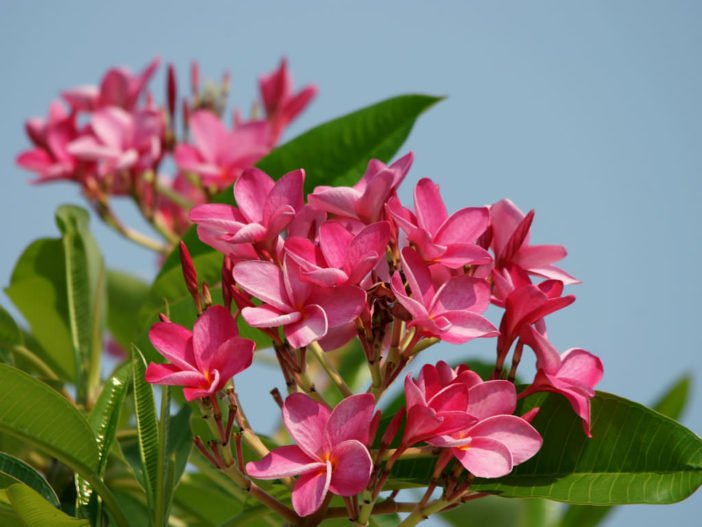
Plumeria rubra f. rubra, Plumeria acuminata, Plumeria acutifolia, Plumeria angustifolia, Plumeria arborea, Plumeria arborescens, Plumeria aurantia, Plumeria aurantiaca, Plumeria bicolor, Plumeria blandfordiana, Plumeria carinata, Plumeria conspicua, Plumeria gouanii, Plumeria incarnata, Plumeria jamesonii, Plumeria kerrii, Plumeria kunthiana, Plumeria lambertiana, Plumeria loranthifolia, Plumeria lutea, Plumeria macrophylla, Plumeria megaphylla, Plumeria mexicana, Plumeria milleri, Plumeria mollis, Plumeria northiana, Plumeria purpurea, Plumeria tenuifolia, Plumeria tricolor
Family: Apocynaceae
Subfamily: Rauvolfioideae
Tribe: Plumerieae
Genus: Plumeria
Color: Pink, white and yellow
Bloom Time: Summer and autumn
Description
Plumeria rubra is a delightful small tree for a garden with a semi-tropical look. It grows as a spreading tree up to 26 feet (8 m) high and wide, and is flushed with fragrant flowers of shades of pink, white and yellow over the summer and autumn.
How to Grow and Care
Although you don’t have to live in the tropics to grow Plumeria in the home garden, you should be aware of its growing requirements beforehand.
Often grown in the garden as an ornamental shrub or small tree, Plumeria plants need to be grown in well-draining soil that is slightly acidic. They also need at least six hours of full sun.
While the plants are fairly tolerant of both salt and windy conditions, they’re not tolerant of cold and must be protected. Therefore, they should be container grown in colder regions. In areas that may be warm most of the time but still fairly prone to cold winters, the plant can be dug up and overwintered indoors. Alternatively, you can sink container grown Plumerias in the ground, bringing them indoors once the temperatures begin to drop in fall. Once warmer temps return in spring, you can return the plants back outdoors.
When growing Plumeria plants in pots, use a coarse, well-draining potting mix—cactus mix or perlite e…
This post has been randomly selected and resteemed @steemeely
Good luck and have a great day.
This is great article and wonderful photography.
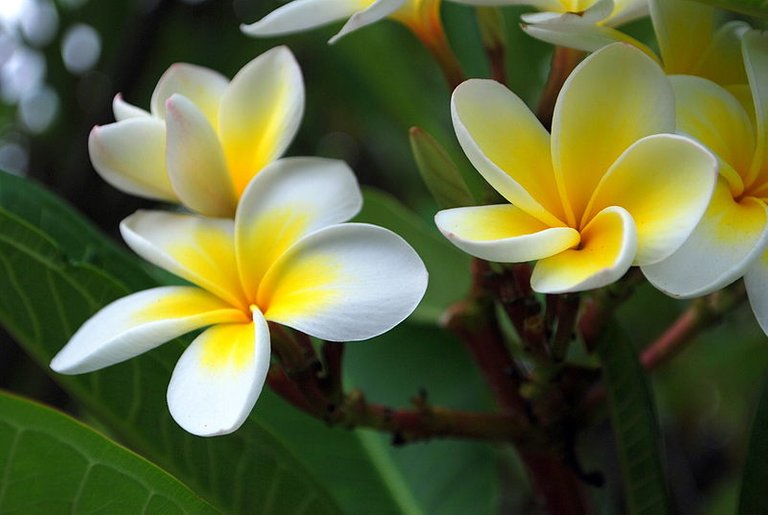
@ctrl-alt-nwo
Upvote Resteem